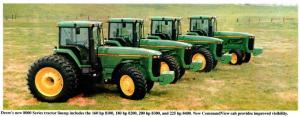1994 - Volume #18, Issue #5, Page #18
[ Sample Stories From This Issue | List of All Stories In This Issue | Print this story
| Read this issue]
Deere Launches All-New 160 to 225 Hp Tractors
 |
 |
That's what farmers told Deere & Company they wanted in a new line of 160 to 225 hp tractors. And that's exactly what Deere promises they'll find in its all-new 8000 Series tractors, which are meant to go head to head with the Ford Genesis and Case-IH Magnums.
Along with 30 other new Deere ag products, the four new 8000 Series tractors were unveiled in August with the most hoopla since the company introduced its 4030 Series more than 20 years ago. The 8000s were on their way to selected North American dealerships by the third week of the month.
Three of the 8000 model tractors - the 160 hp 8100, the 180 hp 8200 and 200 hp 8300 - replace Deere's 4560, 4760 and 4960, respectively. The fourth, the 225 hp 8400, provides the most pto hp. and lift capacity of any row-crop tractor in the industry, according to the company.
Even though the 60 Series remains a "benchmark" of popularity in Deere tractor history, the 8000 Series drastically improves upon it, according to Jim Wright, tractor marketing manager for Deere, who says the company started "with a clean slate" in designing the new tractors, basing it on extensive farmer/dealer feedback.
The tractors range in price from about $80,000 for the 8100 up to $120,000 for the 8400. Here's what they look like:
Powertrain performance - The 8100, 8200 and 8300 are powered by a 6-cyl. 7.6 liter diesel; the 8400 by a new 6-cyl. 8.1 liter Deere diesel. Both engines meet 1996 emissions standards, both are turbocharged, and both are air-to-air intercooled for in-creased performance.
The engines also feature an electronic governor that provides consistent engine performance and up to a 10 percent pto power surge within the constant power range. That means as much as 16 to 22 per-cent additional pto horsepower is automatically available to pull through tough spots. The electronic governor also provides a Field Cruise feature for maintaining consistent ground speed in light load operations.
All four 8000 models use the same 16-speed forward by 4-speed reverse electronic power shift transmission. It provides eight gears in the working range, evenly spaced in 13 percent (about 1/2 mile per hour) increments.
Hydraulic performance - The pressureand-flow hydraulic system on the 8000s features a gear pump for the steering and brakes and a separate axial-piston pump for the hitch and selective control valves. Maximum pressure is 2,900 psi, the highest in the industry, according to Deere. Standard hitch lift capacity is 10,400 lbs. for the 8100 and 8200; 11,700 lbs. for the larger models.
Deere says the system provides the highest flow rate (30 gpm) from one selective control valve (SCV) of any machine on the market.
Maneuverability - Deere's research showed that another thing farmers wanted most in a new line of tractors was increased maneuverability. They get that with the 8000's 17-ft. turning radius (when set for 30 in.-rows). The tractors turn so short, they can do a figure 8 inside the sharpest turn radius of a Case Magnum, according to Deere officials. They also turn shorter than Ford Genesis tractors - even when equipped with Ford's optional "Super Steer" axle.
A newly patented chassis design is largely responsible for the big gains in maneuver-ability. The 8000 Series chassis design positions the engine 10 in. higher and 44 in. forward of the 60 Series, providing a lot more clearance between tires and frame. The chassis design also provides a better weight split on both standard and MFWD configurations for increased stability, plus better ballasting flexibility to optimize drawbar performance and fuel efficiency.
Visibility - With radiator and front weights moved forward, and a narrower, forward-slanting hood, the 8000 chassis design also results in improved visibility on each side of the tractor. For example, in 30-in. rows both rows underneath the tractor are easily visible to the operator. Likewise, the new CommandView cab, with 62 sq. ft. of glass, enhances visibility forward, sides and rear.
Serviceability - Daily engi

Click here to download page story appeared in.

Click here to read entire issue
To read the rest of this story, download this issue below or click here to register with your account number.




